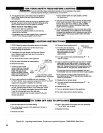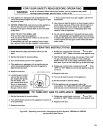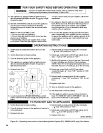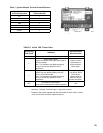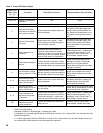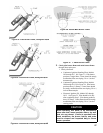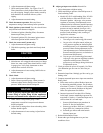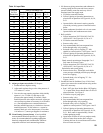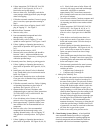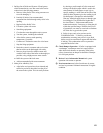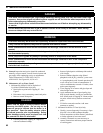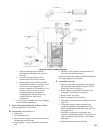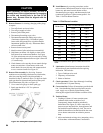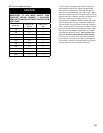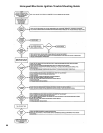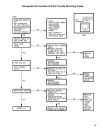60
h. Follow instructions TO TURN OFF GAS TO
APPLIANCE. See Figure 48, 49, 50, or 51.
Drain boiler and system piping.
i. Remove drain valve. Thoroughly wash boiler
water passages with high pressure spray through
drain valve tapping.
j. Fill boiler to normal waterline. If water in gauge
glass is not clear, repeat procedure starting at
step b.
k. Remove surface blow-off piping. Install 1 NPT
plug in Tapping "L". See Figure 2.
4. Add Boiler Water Treatment.
a. Remove safety valve.
b. Pour recommended compound into boiler
through safety valve opening.
c. Reinstall safety valve in Tapping "E" with
spindle in vertical position. See Figures 1 and 2.
d. Follow Lighting or Operating Instructions to
place boiler in operation. See Figure 48, 49, 50,
or 51.
e. Boil water or heat water to 180°F.
f. Measure boiler water alkalinity. pH should be
between 7 and 11. Add recommended water
treatment chemicals, if necessary, to bring the pH
within the specied range.
5. If unsteady water line, foaming or priming persist:
a. Follow Lighting or Operating Instructions to
place boiler in operation. See Figure 48, 49, 50,
or 51.
b. Install gate valve (shut-off valve) in Hartford
Loop. Install drain valves in return main and at
boiler. See Figure 23.
c. Connect hoses from drain valves to oor drain.
Close gate valve in Hartford Loop. Open drain
valve in return main.
d. Fill boiler to normal water line. Follow Lighting
or Operating Instructions to place boiler in
operation. See Figure 48, 49, 50, or 51.
e. Operate boiler for at least 30 minutes after
condensate begins to run hot. Follow instructions
TO TURN OFF GAS TO APPLIANCE. See
Figure 48, 49, 50, or 51.
f. Close all radiator valves. Remove all supply
main air valves. Plug openings in supply main.
g. Drain approximately 5 gallons of boiler water
into container. Mix in recommended boil-out
compound.
h. Remove safety valve. Pour recommended
compound into boiler through safety valve
opening. Reinstall safety valve in Tapping "E"
with spindle in vertical position. See Figures 1
and 2.
i. Follow Lighting or Operating Instructions to
place boiler in operation. See Figure 48, 49, 50,
or 51. Slowly feed water to boiler. Water will
rise slowly into supply main and back through
return main. Adjust ow to maintain
approximately 180°F water from return main
hose. Continue until water runs clear from hose
for at least 30 minutes.
j. Turn off water to boiler. Continue to operate until
excess water is removed from boiler and system
(by steaming) and boiler water reaches normal
waterline.
k. Follow instructions TO TURN OFF GAS TO
APPLIANCE. See Figure 48, 49, 50, or 51.
Open all radiator valves. Reinstall all supply
main air valves. Open gate valve in Hartford
Loop.
l. Allow boiler to cool until crown sheet is no
longer too hot to touch. Close drain valves at
boiler and in return main. Fill boiler slowly to
normal waterline.
m. Follow Lighting or Operating Instructions to
place boiler in operation. See Figure 48, 49, 50,
or 51. Allow boiler to steam for 10 minutes.
Drain one quart of water from lower Gauge
Glass tting.
n. Drain second quart sample from lower Gauge
Glass tting. If sample is not clear, repeat cycle
of draining boiler and return main and relling
boiler until sample is clear.
o. If after normal operation boiler water becomes
dirty from additional system piping sediment
returning to boiler.
i. Complete steps 5a through 5n.
ii. Complete steps 3a through 3k.
6. Make pH or Alkalinity Test.
a. After boiler and system have been cleaned and
relled as previously described, test the pH of
the water in the system. This can easily be done
by drawing a small sample of boiler water and
testing with Hydrion paper which is used in the
same manner as litmus paper, except it gives
specic readings. A color chart on the side of the
small Hydrion dispenser gives the reading in pH.
Hydrion paper is inexpensive and obtainable
from any chemical supply house or through your
local druggist. The pH should be higher than 7
but lower than 11. Add recommended water
treatment chemicals, if necessary, to bring the pH
within the specied range. With this lower level
of protection, care must be exercised to eliminate
all of the free oxygen in the system.
b. Boiler is now ready to be put into service.
N. Clean Heating System (Water). A local qualied
water treatment chemical specialist is a suggested
source for recommendations regarding appropriate
chemical compounds and concentrations which are
compatible with local environmental regulations.



